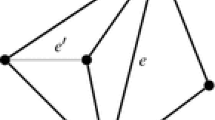Abstract
Let T be a triangulation of a simple polygon. A flip in T is the operation of replacing one diagonal of T by a different one such that the resulting graph is again a triangulation. The flip distance between two triangulations is the smallest number of flips required to transform one triangulation into the other. For the special case of convex polygons, the problem of determining the shortest flip distance between two triangulations is equivalent to determining the rotation distance between two binary trees, a central problem which is still open after over 25 years of intensive study. We show that computing the flip distance between two triangulations of a simple polygon is NP-hard. This complements a recent result that shows APX-hardness of determining the flip distance between two triangulations of a planar point set.











Similar content being viewed by others
Notes
The flip-kernel of D might not be completely inside the polygon D. This is in contrast to the “visibility kernel” of a polygon.
The exact time bounds shown in the proof are irrelevant for the NP-hardness reduction (which even requires a different model of computation). We mention them only as they may be of general interest.
Actually, any dual transform will do. When thinking of the rounding process as a continuous transformation, a change of the order type would involve a collapsing triangular cell of the dual arrangement, indicating a “close” point triple.
References
Abel, Z., Ballinger, B., Bose, P., Collette, S., Dujmović, V., Hurtado, F., Kominers, S., Langerman, S., Pór, A., Wood, D.: Every large point set contains many collinear points or an empty pentagon. Graphs Comb. 27, 47–60 (2011)
Aichholzer, O., Mulzer, W., Pilz, A.: Flip distance between triangulations of a simple polygon is NP-complete. In: Proceedings of 29th European Workshop on Computational Geometry, pp. 115–118. EWCG, Braunschweig (2013)
Aichholzer, O., Mulzer, W., Pilz, A.: Flip distance between triangulations of a simple polygon is NP-complete. In: Bodlaender, H.L., Italiano, G.F. (eds.) Algorithms—ESA 2013—21st Annual European Symposium, Sophia Antipolis, France, 2–4 September 2013. Lecture Notes in Computer Science, vol. 8125, pp. 13–24. Springer, Heidelberg (2013)
Bose, P., Hurtado, F.: Flips in planar graphs. Comput. Geom. 42(1), 60–80 (2009)
Canny, J.F., Donald, B.R., Ressler, E.K.: A rational rotation method for robust geometric algorithms. In: Proceedings of 8th Annual ACM Symposium on Computational Geometry (SoCG 1992), pp. 251–260. ACM Press, New York (1992)
Chazelle, B., Guibas, L.J., Lee, D.T.: The power of geometric duality. BIT 25(1), 76–90 (1985)
Culik II, K., Wood, D.: A note on some tree similarity measures. Inf. Process. Lett. 15(1), 39–42 (1982)
Edelsbrunner, H., O’Rourke, J., Seidel, R.: Constructing arrangements of lines and hyperplanes with applications. SIAM J. Comput. 15(2), 341–363 (1986)
Eppstein, D.: Happy endings for flip graphs. J. Comput. Geom. 1(1), 3–28 (2010)
Hanke, S., Ottmann, T., Schuierer, S.: The edge-flipping distance of triangulations. J. UCS 2(8), 570–579 (1996)
Hurtado, F., Noy, M., Urrutia, J.: Flipping edges in triangulations. Discrete Comput. Geom. 22, 333–346 (1999)
Husemöller, D.: Elliptic Curves. Graduate Texts in Mathematics. Springer-Verlag, New York (2003)
Hwang, F., Richards, D., Winter, P.: The Steiner Tree Problem. Annals of Discrete Mathematics. North-Holland, Amsterdam (1992)
Kanj, I.A., Xia, G.: Flip distance is in FPT time \(O(n+ k \cdot c^k)\). (2014). http://arxiv.org/abs/1407.1525
Lawson, C.L.: Transforming triangulations. Discrete Math. 3(4), 365–372 (1972)
Lawson, C.L.: Software for \(C^1\) surface interpolation. In: Rice, J.R. (ed.) Mathematical Software III, pp. 161–194. Academic Press, New York (1977)
Lu, B., Ruan, L.: Polynomial time approximation scheme for the rectilinear Steiner arborescence problem. J. Comb. Optim. 4(3), 357–363 (2000)
Lubiw, A., Pathak, V.: Flip distance between two triangulations of a point-set is NP-complete. In: Proceedings of 24th Canadian Conference on Computational Geometry (CCCG), pp. 127–132. CCCG, Charlottetown (2012)
Pilz, A.: Flip distance between triangulations of a planar point set is APX-hard. Comput. Geom. 47(5), 589–604 (2014)
Rao, S.K., Sadayappan, P., Hwang, F.K., Shor, P.W.: The rectilinear Steiner arborescence problem. Algorithmica 7, 277–288 (1992)
Shi, W., Su, C.: The rectilinear Steiner arborescence problem is NP-complete. In: Proceedings of 11th Symposium on Discrete Algorithms (SODA), pp. 780–787. SODA, San Francisco (2000)
Sleator, D., Tarjan, R., Thurston, W.: Rotation distance, triangulations and hyperbolic geometry. J. Am. Math. Soc. 1, 647–682 (1988)
Trubin, V.: Subclass of the Steiner problems on a plane with rectilinear metric. Cybernetics 21, 320–324 (1985)
Urrutia, J.: Algunos problemas abiertos. In: Proceedings of IX Encuentros de Geometría Computacional, pp. 13–24. Universitat de Girona, Girona (2001)
Acknowledgments
O. Aichholzer and A. Pilz were supported by the ESF EUROCORES programme EuroGIGA - ComPoSe, Austrian Science Fund (FWF): I 648-N18. W. Mulzer was supported in part by DFG project MU/3501/1. Part of this work was done while A. Pilz was recipient of a DOC-fellowship of the Austrian Academy of Sciences at the Institute for Software Technology, Graz University of Technology, Austria. Preliminary versions have appeared as O. Aichholzer, W. Mulzer, and A. Pilz, Flip Distance Between Triangulations of a Simple Polygon is NP-Complete in Proc. 29th EuroCG, pp. 115–118, 2013, and in Proc. 21st ESA, pp. 13–24, 2013 [2, 3].
Author information
Authors and Affiliations
Corresponding author
Additional information
Editor in Charge: Herbert Edelsbrunner
Rights and permissions
About this article
Cite this article
Aichholzer, O., Mulzer, W. & Pilz, A. Flip Distance Between Triangulations of a Simple Polygon is NP-Complete. Discrete Comput Geom 54, 368–389 (2015). https://doi.org/10.1007/s00454-015-9709-7
Received:
Revised:
Accepted:
Published:
Issue Date:
DOI: https://doi.org/10.1007/s00454-015-9709-7




